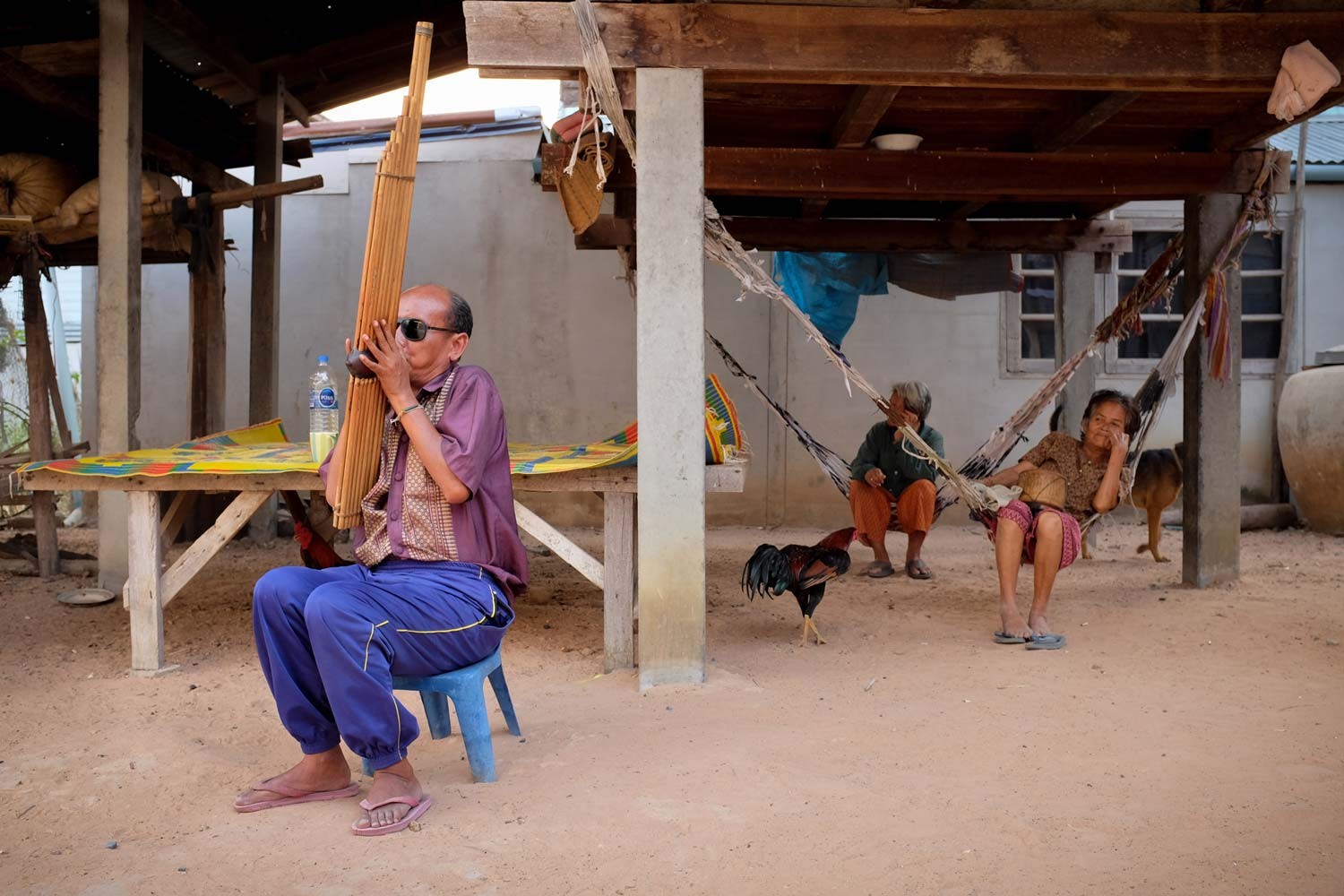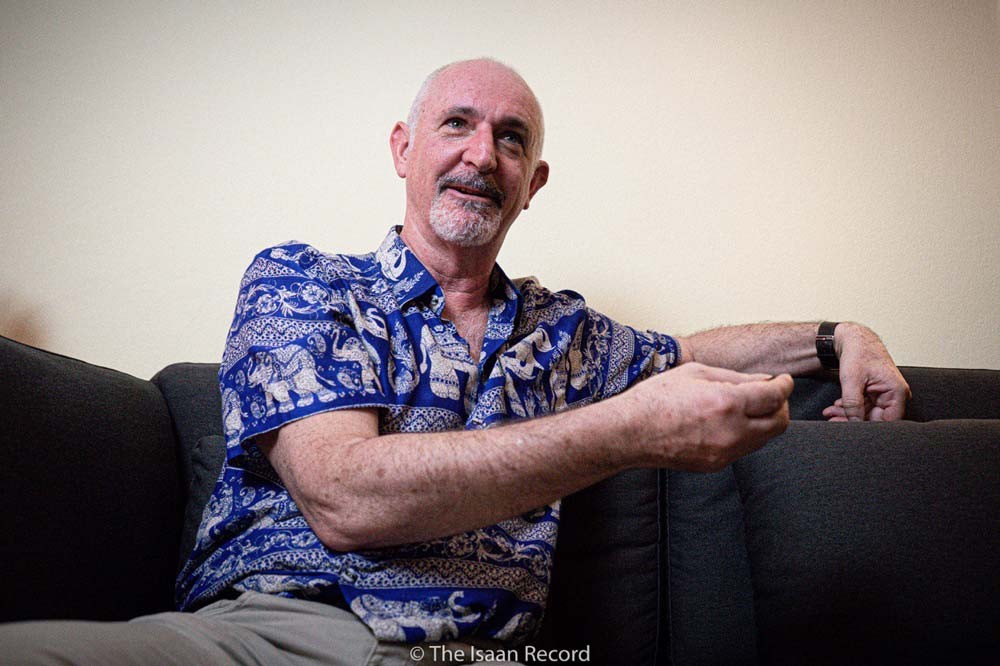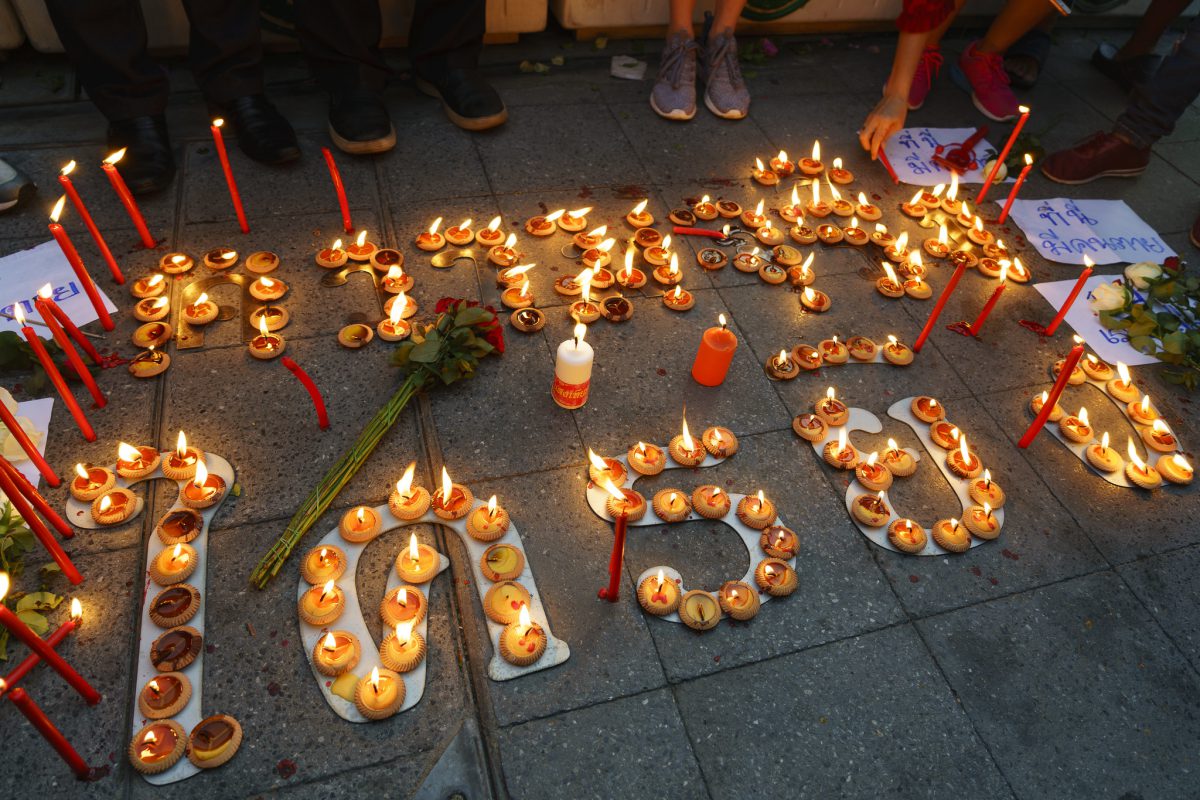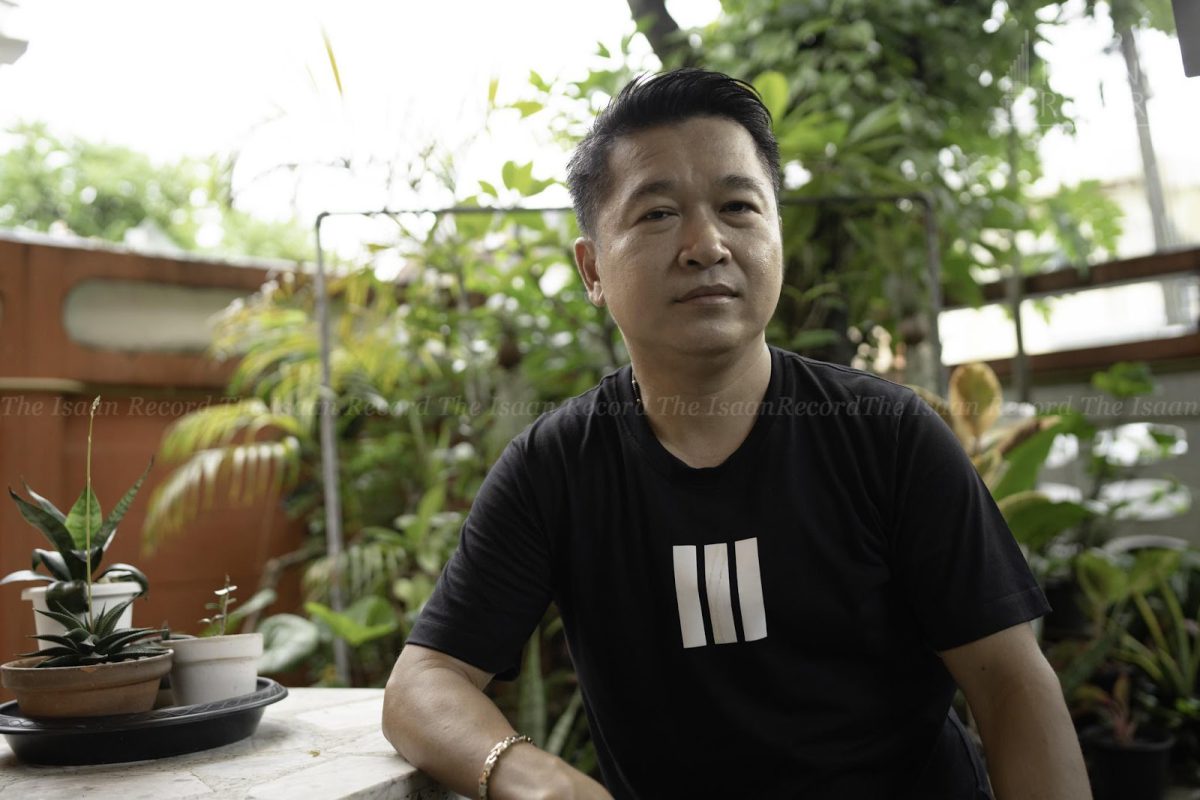

The Soul of Molam (15) – Masters of the khaen and the future of disappearing molam styles
John Garzoli is one of those rare Westerners who’s immersed himself deeply in the music traditions of Isaan. An Australian with a Ph.D. in ethnomusicology, he has brought his sensibilities as an accomplished musician into his anthropological research of the cultural role of music.
He did his doctoral research in 2011 and 2012 after becoming interested in the ensemble Boonhugsa that was combining Isaan music with jazz. Working with the leader of the band, Warong “Yod” Boonaree, led him to look more deeply at the history of khaen-playing and molam in Isaan.
The group that formed around John’s research carried out interviews with many of the master players of the khaen, trying to capture the essence of this traditional form
They continue to be concerned that traditional practices of Isaan music might disappear because younger generations are losing the connection to authentic, traditional performances of lam klon, which features a male-female singing duo accompanied by a single khaen.
John’s also been looking at the ways that molam and the khaen have evolved in the past few decades, as well as at intercultural musical synthesis “by which khaen and phin, which are part of molam, are integrated into Western musical forms.”
The Isaan Record took an opportunity to sit down with John and discuss in depth his work and what his research says about molam’s past, present, and future.
This interview has been edited for brevity and clarity. Interested readers can find the full version of the interview here.

Ethnomusicologist John Garzoli at the Khon Kaen office of The Isaan Record in February 2020. Photo by Adithep Chanthet
The Isaan Record (IR): What did you focus on in your research of Isaan molam traditions?
John Garzoli (JG): From my discussions with performers of the younger generation, I became concerned that the music in its traditional context–by which I mean the intergenerational transmission of playing, learning to play, learning the melodies, and learning the role of the khaen in society–was being undermined as a result of modernization in the Thai rural context.
So we wanted to see whether this was a problem that threatened traditional practice. We also felt that there wasn’t very much archival footage–or any footage–of khaen players and the idiosyncratic style which is probably less the case now as a bit more work has been done on it. But in 2011, there was almost nothing recorded in the universities and much less on YouTube.
So we wanted to do our own research–myself, Yod [Warong Boonaree] from Ubon Ratchathani and a Thai classical musician, Pokpong Khamprasert, who comes from a hereditary musical family.
IR: Who did you interview and what did you learn?
JG: We interviewed seven or eight mo khaen of an older generation in Ubon Ratchathani [shortened Ubon] who were all either rice farmers or involved in some traditional agricultural way of life, rather than professional musicians or academics.
We visited them in their homes and they explained their life story in Isaan music and performed examples of their musical style. The musical styles were all idiosyncratic and slightly unique because they each had their own style that they had developed themselves. But at the same time they were all sort of in a basic Ubon register of playing.
And then we found that they were all connected through a single agent in the 1970s. They all knew Klom Tatawong who was the most senior khaen player in the area and many of them were playing his instruments, instruments that he had made. Many had taken lessons from him.
Each of these senior khaen players in a way concluded with the sense that Ubon’s molam and khaen tradition was all something of the past. So none of them had any belief that khaen-playing had any future.
In fact, [they all said] it had already died or was being decimated. They had no students themselves and the young people in their villages had no interest in playing the khaen. They felt that whatever cultural meaning had been invested in it previously had been washed away.
It was sad that the things that they cared about deeply probably wouldn’t survive beyond their generation. They each relayed that story in their own words so I don’t think that they contrived this idea of their tradition being under threat. I think they had a genuine belief, individually or as a cohort of people of that age, that they were the last of a tradition that they believed stretched back hundreds, maybe thousands, of years.

John Garzoli playing, “The pursuit of imaginary sounds,” with the ensemble, Khrueang Sai Pasom, at Chulalongkorn University on January 24, 2020.
IR: Do you think that Isaan music has changed a lot in the past 30 years?
JG: Yeah, I think Isaan music has undergone a number of changes in the past 30 years. The introduction of the pong lan ensemble is one change. Pong lan includes a suspended xylophone, khaen, phin, and other instruments.
It is considered by some to be an invented tradition because it’s so recent and some academics question whether it reflects anything about Isaan culture or traditional culture when it’s a sort of a made-up idea. But it is an ensemble that’s popular in schools and has become a genre in itself.
There’s also been the development of lam sing as a popular music form. Its history is quite interesting because it emerged from lam klon which is a type of vocal repertoire involving a male and female and single khaen which then gradually expanded through lam mu and lam phloen. It features not only molam and khaen but has electric instruments and often dances and big productions.
There’s now also a number of ensembles like Paradise Bangkok Molam International Band and Boonhugsa that explicitly mix western music and more contemporary western concepts of dance music with Isaan instruments and Isaan roots. They have high quality, they are the real guys, so it’s not students who are doing something that’s a bit more contrived, it’s musicians with the skills to accompany lam klon playing in another context.
More recently, maybe in the last five years, there’s been another change whereby electronic dance music and even the types of minimalist pop music have involved the khaen. There is an ensemble in France called Limousine and they play a sort of minimalist form of rock music. So it’s like a jazz ensemble or a rock ensemble with elements from Isaan incorporated. And it doesn’t change very much; it’s just very static. And there is electronic dance music that incorporates Isaan vocalization, khaen, and I think maybe phin, in some settings as well.
There are two ways of understanding these changes. One is internal growth whereby people who are within the tradition adapt their skills playing in an “old” style to new contexts. The other is the relatively superficial appropriation of Isaan instruments which are incorporated into forms of Western music
**See John playing with Boonhuksa here.**
IR: Do you think that in the future, molam or lam klon, is going to disappear?
JG: Lam klon is already largely stripped of its social context due to changes in the organization of village life. Khaen is taught in universities and appears in competitions which provide some opportunities and incentive to participate in khaen performance but nothing like what it was before. It’s fundamentally being displaced as an entertainment in public events. So lam klon, which is that basis for khaen playing, is already highly marginalized. But I don’t see the same sorts of risks that I was concerned about a few years ago.
I don’t think the khaen will disappear or the idea of Isaan music will be diminished because its cultural value is now recognized in universities and media. The khaen has become a popular symbol of Isaan identity and there are political reasons that will ensure its survival. It’s too deeply entrenched in the culture and now it’s very well supported.
It will, however, continue to transform as a result of its use in contemporary popular music which places different stylistic requirements on performers who often jettison traditional melodies to fit in.
IR: What are some of the concerns expressed by the molam performers you spoke to about the survival of their tradition?
JG: There is a fear among the traditional performers I spoke with who were concerned that the specific way of performing that comes from accompanying lam klon is being lost through lack of expertise in younger players.
So in the minds of the traditional players, a mo khaen is someone who can accompany molam–the possession of those skills and attributes that is the mark of a proper khaen player. It is not whether they can play a few melodies; it’s whether they can accompany in lam klon. For khaen performers this means understanding essential patterns that are associated with tang san and tang yao which are the primary musical modes. While san and yao mean short and long respectively, these terms don’t accurately describe musical practice. The simplest explanation may be to characterise thang san as the ‘major’ sounding modes and thang yao as the “minor” sounding modes. There are numerous melodic variations of these modes that are regional but in general the performance of these requires a great level of knowledge and skill.
This knowledge and this level of specialized skill is not actually required very much in some of the modern music so senior performers are concerned that while universities may train competent and capable khaen players, the regional diversity and richness of the tradition will disappear along with a commitment to older forms of practice.
**See John playing earlier this year at Chulalongkorn University here.**
IR: What would you like to see in the future of Isaan music?
JG: Personally, I’d like to see the music and its diversity prosper as widely as possible. I understand this will take institutional support. I encourage the universities, and to the extent that I have any influence, to support them in talking about the khaen, teaching the khaen, and preserving the knowledge system that underpins the khaen. The intergenerational transmission is probably lost. I don’t know if it will ever come back.
The khaen has much more prominence in social life in Isaan, so much that it just seems like it’s not something exceptional that Isaan people do but something that’s just entrenched in social life in Isaan. But it is an exceptional musical system and a beautiful poetic system that accompanies the lam klon that should not be lost. It is a particular form of poetry that is highly unique and highly specialized and requires an enormous amount of skill.
It’s quite separate though not completely separate from khaen playing because the khaen is trying to match it. I would like to see these supported. At least Khon Kaen University, where I’m at now, gives proper support for this.
Maybe it sounds as if I’m being a bit too negative by being concerned about the traditional, intergenerational transmission being lost, but on balance it’s much, much better than maybe I would’ve thought about it ten or 15 years ago.
Now there is Pongsapon “On” Upan at Khon Kaen University who’s now becoming world famous for his performances and he’s heavily supported even by diplomats who have accompanied him around the world and are funding his trips. So there’s a sense that there’s something at stake here.
I think Isaan identity can be reflected in a really positive light without making anything up. So you can find young performers of the khaen like On who performs with real molam, who’s deeply connected to the tradition and who’s a highly skilled musician. He’s shown that from a musical and cultural perspective, there’s something interesting to say and also something worth preserving and pursuing in order to ensure that it doesn’t fade away.

John Garzoli jamming at the The Isaan Record office. Before studying Ethnomusicology, he worked as a professional musician in Thailand from 1996 to 2006. Photo by Adithep Chanthet
IR: In the past ten years has there been more interest or awareness about Isaan identity? If so, where has it been coming from?
JG: I believe that there is a sense of regional pride. I think there are probably a number of factors playing into this. At Khon Kaen University, they do emphasize particularly the Khon Kaen tradition of music through bands. It’s become embedded and they have created a network and an institution around it.
There is also an acknowledgement that Isaan culture has been repressed politically in the past and there’s been some pushback against that. There is a general sense that Isaan identity and culture is distinct from Central Thai or Bangkok identity and culture and that there’s significant political stakes involved in that through the color of people’s shirts.
And there are political reasons why Isaan identity might now have become more important. There are opportunities through Facebook and other things to express that importance which weren’t available a few years ago, so community groups can gather in places like social media to strengthen their claims about recognition of their identity or their language.
I think these various phenomena are just the result of some political oppression locally and then the opportunities the technological means to push back against that. There are probably a range of other factors feeding into this.
But it seems to be that there has been a significant elevation in the status of what it is to be an Isaan person in the last 10 or 15 years in Thailand and that’s not just driven by taxi drivers in Bangkok listening to Luk Thung and eating som tam. I think it’s probably the result of the strengthening sense of what it means to be Isaan in Isaan.
IR: You said that the intergenerational transmission, in the minds of your sources, was dying in 2011/12. Would you be more optimistic now?
JG: I think that once intergenerational transmission is lost as a result of changes in social practice and how societies are organized in rural environments, it’s really hard to recapture that.
So, no, I don’t think that if I were to go back and ask those musicians that they would be any more optimistic about the likelihood of reviving the traditional way that the khaen had been taught.
What’s been more encouraging, I think, is the fact that the khaen is now in schools and universities. The consequences of having this upsurge in regional identity means that the traditional practices can be supported in institutions. That means that students can take lessons at school or at the university, or in other places. So it has gone from being something that was studied at the margins and generally falling off the edge of what society thinks is important, to being placed in institutions where this subject now gains another sort of prestige.
My only concern–and I’m not sure how serious this is–is that not all of the diversity of the rural practices can be captured in the universities. So Khon Kaen University has a strong music program but it’s going to teach khaen playing, for example, in the local style of this part of the region. The absence of a music program doing something similar in Kalasin, Roi Et, or Ubon means that the particular idiosyncrasies of those traditions are not supported in the same by the institutions.
So there is always a bit of a risk that the loss of traditions means the loss of diversity and the institutionalization of something like the khaen means the concentration of the playing styles of certain individuals from certain geographical regions.This is great as far as it goes, but what gets lost is the regional variety and individual style of masters who are not involved in formal education.
I really hope that the recent popularity of the khaen due to its inclusion in popular music does not come at the cost of the traditional musical practice which is the source of khaen playing.
John Garzoli received his Ph.D. in ethnomusicology from Monash University where he is an Adjunct Research Fellow. He is a recipient of many awards and fellowships, including the “2011 Prime Minister’s Asia Endeavour Award” and the “2106 Endeavour Post-doctoral Research Fellowship.” He has been a visiting international scholar at Khon Kaen University many times and was a 2019 “Artist in Residence” in the Faculty of Fine and Applied Arts at Chulalongkorn University, focusing on the use of guitar in traditional Thai music.
His research involves Isaan music, traditional and contemporary Thai music, pedagogy, intercultural musical synthesis, performance practice, aesthetics, and jazz. He has published widely, including in Musicology Australia and The International Journal of Community Music.
Read this interview in Thai
The Soul of Molam (15) – Masters of the khaen and the future of disappearing molam styles




